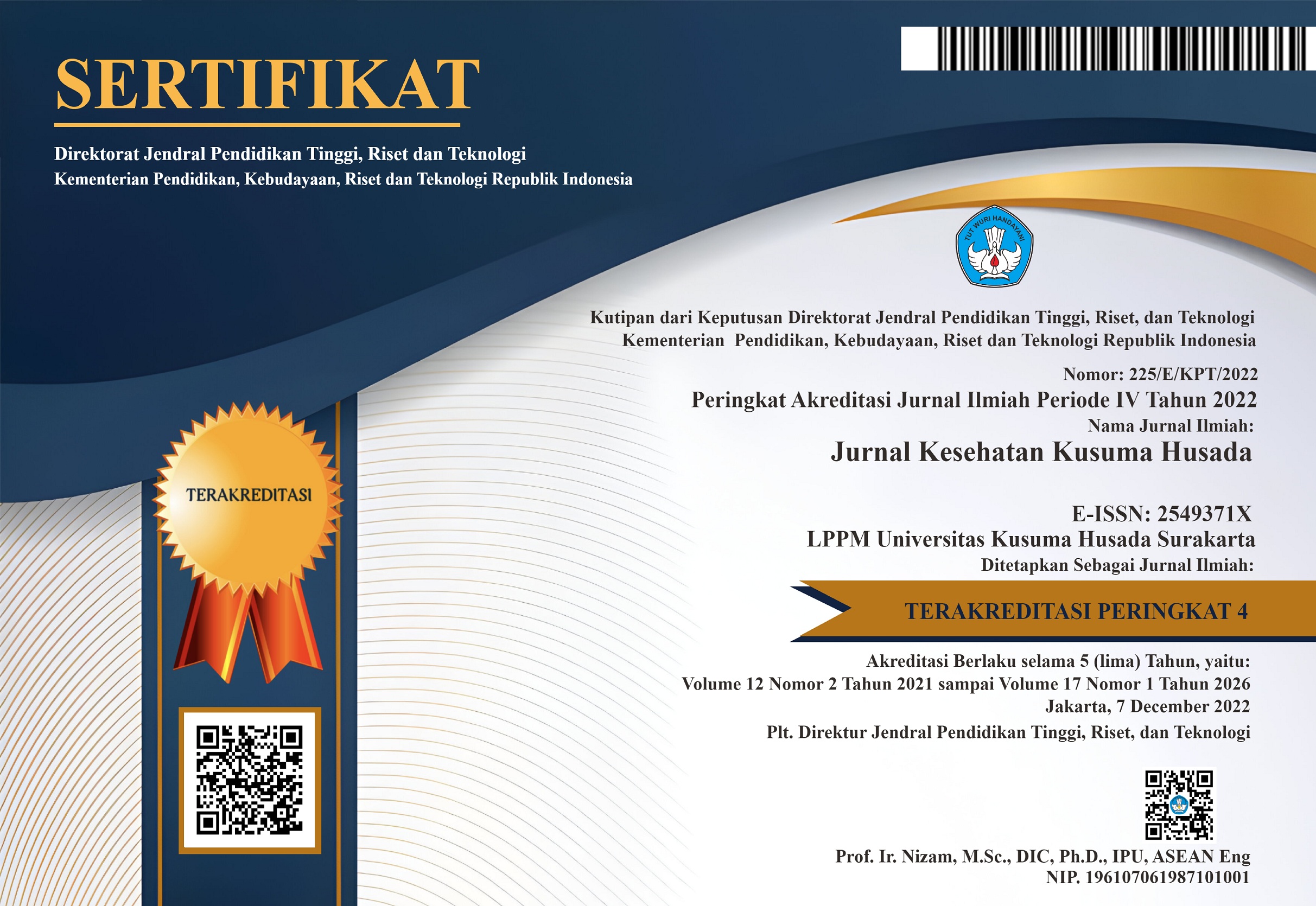PERBEDAAN INTENSITAS NYERI HAID ANTARA KONSUMSI KUNYIT ASAM DAN KOMPRES HANGAT PADA MAHASISWI STIKES KUSUMA HUSADA SURAKARTA
Abstract
ABSTRAK
Nyeri haid merupakan suatu gejala dan bukan suatu penyakit, hal ini timbul karena kontraksi disritmik miometrium yang menyebabkan otot menegang, tidak hanya terjadi pada otot perut, tetapi juga pada otot penunjang lain yang terdapat di bagian punggung bawah, pinggang, panggul, dan paha hingga betis. Dismenore menyebabkan banyak siswa yang absen dari sekolah, kehilangan konsentrasi belajar, dan aktivitas sosialnya terganggu. Beberapa wanita sampai pingsan karena tidak bisa menahan rasa nyeri akibat dismenore, ada yang merasa sangat mual bahkan sampai muntah. Penelitian bertujuan untuk mengetahui perbedaan intensitas nyeri haid antara penatalaksanaan konsumsi kunyit asam, dan kompres hangat pada mahasiswi STIKes Kusuma Husada Surakarta.Jenis penelitian adalah analitik eksperimental dengan desain Randomized Controlled Trial (RCT). Didapatkan sampel sejumlah 60 orang, 30 orang kelompok konsumsi kunyit asam dan 30 orang kelompok kompres hangat. perbedaan penatalaksanaan nyeri haid antara 2 kelompok tersebut diuji menggunakan Mann Whitney test.Hasil penelitian menunjukkan bahwa tidak ada perbedaan intensitas nyeri haid antara penatalaksanaan konsumsi kunyit asam, dan kompres hangat (p=0.743). keduanya efektif untuk mengurangi intensitas nyeri haid.Kesimpulan penelitian adalah konsumsi kunyit asam, dan kompres hangat dapat digunakan untuk mengurangi intensitas nyeri haid pada perempuan, dengan efektivitas yang sebanding.
ÂÂ
Kata kunci: intensitas nyeri haid, konsumsi kunyit asam, kompres hangat.
ÂÂ
ÂÂ
ABSTRACT
Menstrual pain is a symptom not a disease, it appears because dysrhythmia myometrium contraction causing tighten the muscles. They are not only occur in the abdominal muscles, but also on the other supporting muscles located on the lower back, hips, pelvis, and thigh to calf. Dysmenorrhea causes many students are absent from school, concentration learning are loss, and social activities are disrupted. Some of the women are faint because they can not endure the pain of dysmenorrhea and the others feel nauseous moreover until vomit. The study is aimed to determine the difference of menstrual pain intensity between consumption of turmeric acid and warm compresses at student of STIKes Kusuma Husada Surakarta. The kind of the study is analytic experimental with Randomized Controlled Trial (RCT) design. The sample of the study is 60 people; 30 people of turmeric acid consumer and 30 peoples of warm compresses. Differences in the effectiveness of the management of menstrual pain between the two groups were tested with Mann Whitney test . The results showed that there was no difference between the effectiveness of turmeric acid consumption and warm compresses (p=0.743). Both of the treatment effective to reduce the menstrual pain intensity. The conclusion of the study is the consumption of turmeric acid, and warm compresses have significant effectiveness to reduce the intensity of menstrual pain in women.
ÂÂ
Keywords: menstrual pain intensity, turmeric acid consumption, warm compresses.
References
Downloads
Issue
Section
License
The copyright of the published articles belongs to Jurnal Kesehatan Kusuma Husada.

This work is licensed under a Creative Commons Attribution 4.0 International License.
















